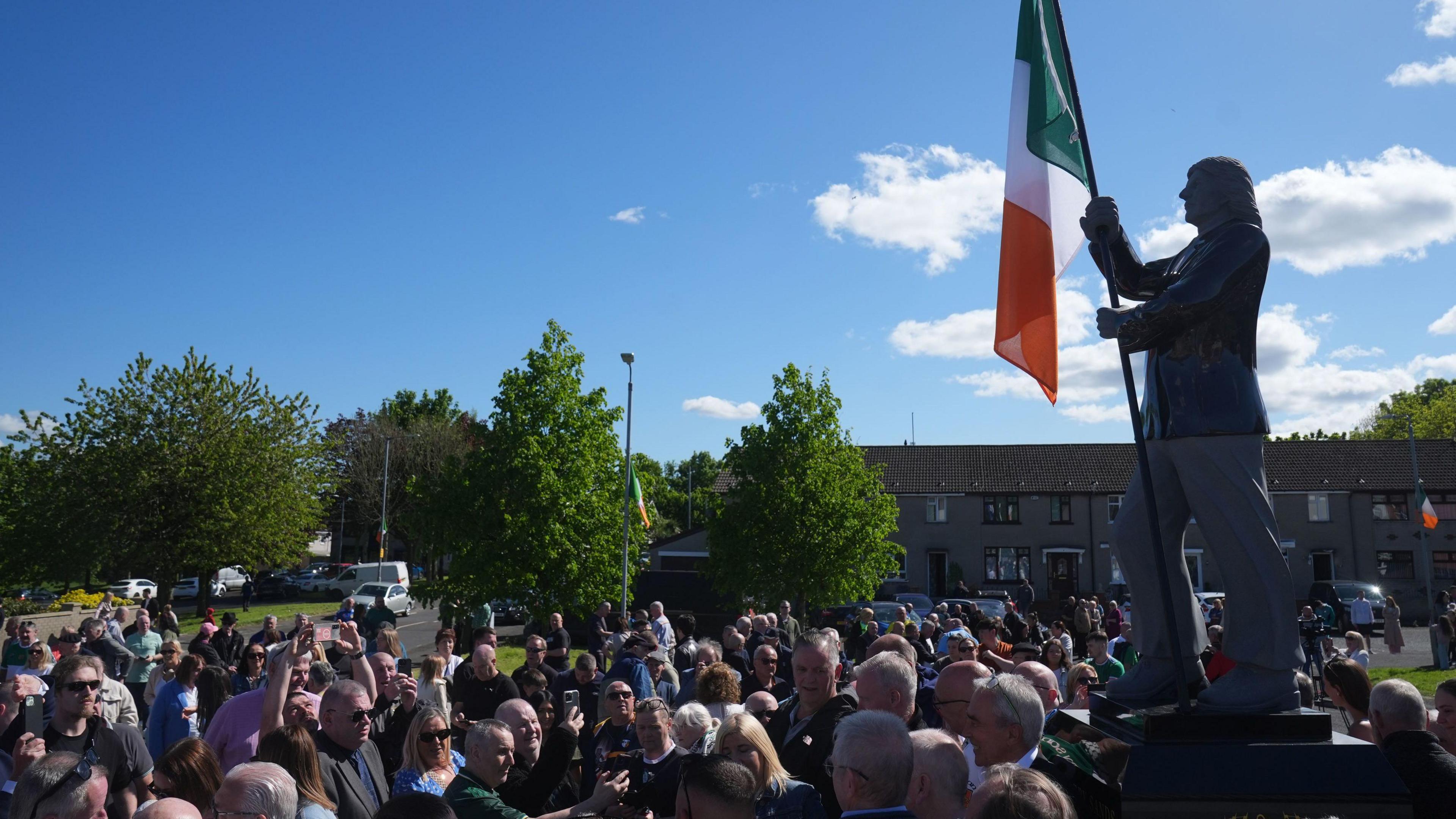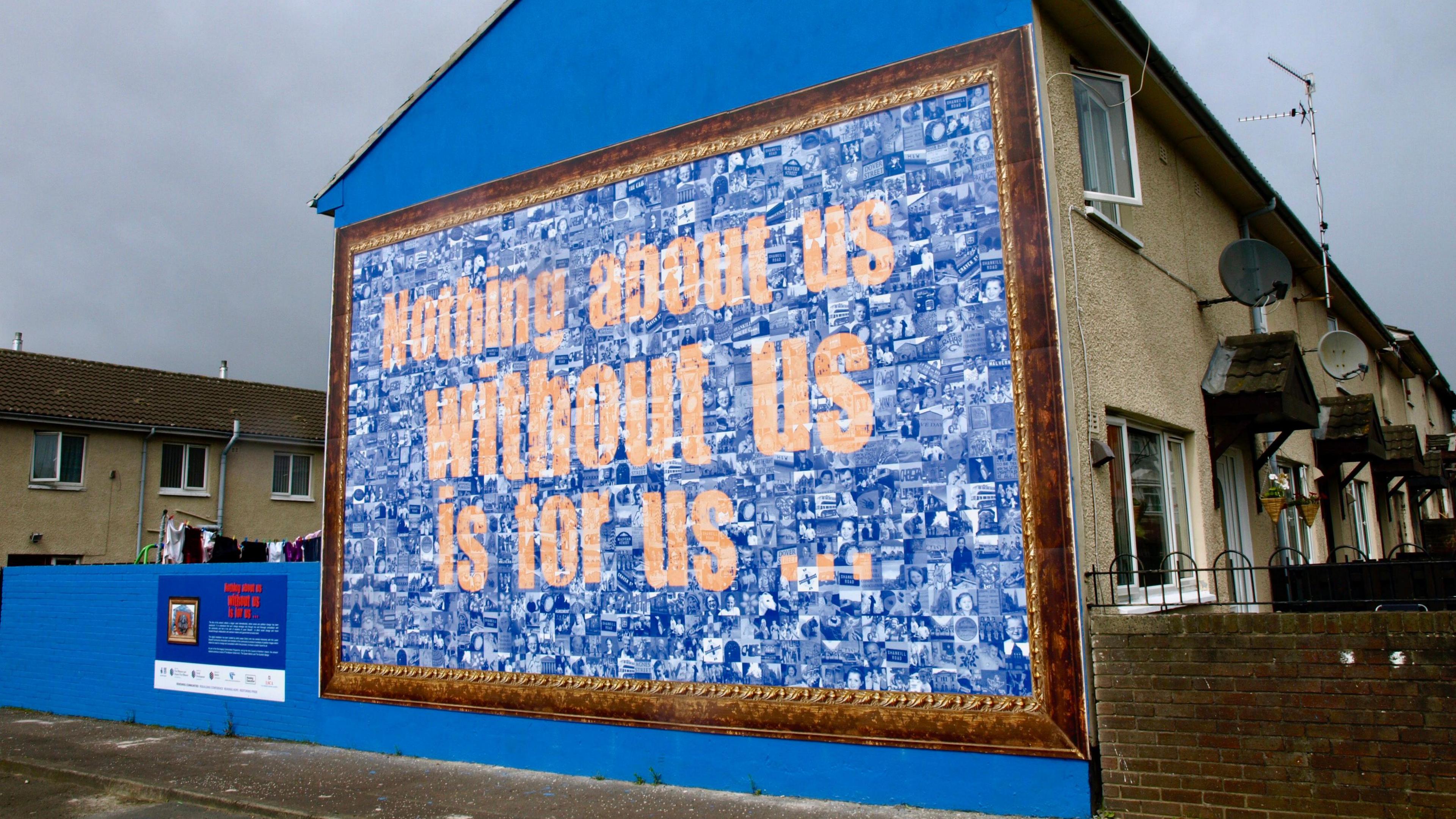Almost 200 paramilitary murals and memorials on public housing land

A paramilitary mural in the Mount Vernon area of north Belfast
- Published
Nearly 200 paramilitary murals and memorials are on Northern Ireland Housing Executive (NIHE) land and property, according to documents obtained by BBC News NI.
The unauthorised loyalist and republican displays have been recorded by the public housing body.
It comes amid calls from the Northern Ireland Assembly for ministers to consider an audit of memorials on public land and to remove paramilitary imagery.
NIHE said issues with murals, memorials and flags "can be difficult to deal with and no single agency can be solely responsible".
It said it continues to work with communities on "re-imaging" projects to change or remove contentious and "territorial" displays.
More than 400 murals and memorials are located on NIHE land and property, according to records released through a Freedom of Information request.
They include more than 300 regarded as "loyalist" or "republican", with the remainder considered "unaligned" or unspecified.
Some 177 of the murals and memorials were related to paramilitary groups, including the IRA, UDA and UVF.
NIHE said an assessment carried out in June to record the number and location of all memorials on its land identified a total of 134.
Earlier this year, a statue of IRA hunger striker Bobby Sands was erected on NIHE land in the Twinbrook area of west Belfast.
Among those who welcomed the monument was First Minister Michelle O'Neill, who defended her decision to attend its unveiling.

A crowd at the unveiling of a statue of Bobby Sands in west Belfast in May
NIHE said the statue was erected "without our permission" and Belfast City Council is continuing to investigate a lack of planning approval.
A loyalist paramilitary mural in the Mount Vernon estate in north Belfast was restored in recent months after being damaged during Storm Darragh last year.
NIHE said "no permission had been sought, nor granted" for the work.
It said there were currently "no plans" to remove it, adding that "safety of our staff and any contractor will be a priority consideration".
The Northern Ireland Assembly last week held a debate on unauthorised memorials on public land.
It followed an Alliance Party motion calling for Stormont ministers to "conduct an audit" of the number of memorials.

Belfast artist Lesley Cherry said the process of "re-imaging" can be "as important as the actual finished project"
The motion also urged ministers to "lead a programme of supporting communities to re-image these memorials by removing paramilitary imagery".
Belfast-based artist Lesley Cherry, who has been involved in re-imaging projects for about 15 years, said it was important to "build relationships" with communities.
"You don't want to be going in and saying, 'This is what you have to do', because they'll just tell you exactly where to go," she said.
"I've seen that happen to organisations over the years, so the process sometimes is as important as the actual finished project for the type of work that I do."
'Coercive control'
Prof Dominic Bryan, from Queen's University Belfast, co-chaired a Stormont body that examined issues with murals and memorials.
"There was no more heated topic than commemoration," he said of his years leading the Commission on Flags, Identity, Culture and Tradition, which published its report in 2021.

Prof Dominic Bryan, who co-chaired a Stormont body that looked at issues over flags, murals and memorials
Prof Bryan said that while people should be able to commemorate in a "respectful" manner, murals and memorials could be used "as forms of coercive control in particular areas".
He urged Stormont's Executive Office to develop a "set of principles" to encourage "respectful commemoration".
"We need to see a move away from military symbols of the past, because local military coercion still takes place - communities are still living with that past," he added.

NIHE said it continues to work with communities on "re-imaging" contentious murals and memorials
In a statement, NIHE said it "does not give consent for memorials on its land, nor do we fund memorials".
It said it has worked with communities to deliver 57 "re-imaging projects".
"Without community support, however, the removal of murals and memorials can create tension and heightened responses," a spokesman said.
"We will continue to support and assist local communities regarding the removal of sectional symbols in their areas where there is a willingness and a readiness to embark on the journey to remove the outward symbols of sectarianism through the medium of art."
Stormont's Executive Office was approached for comment.
Related topics
- Published19 August

- Published1 November 2024
